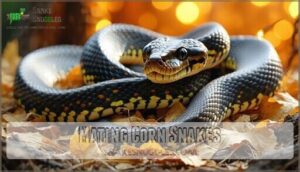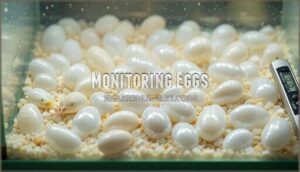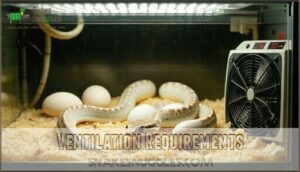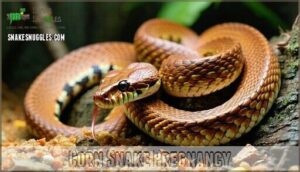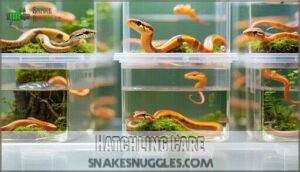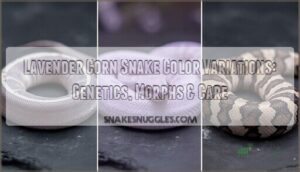This site is supported by our readers. We may earn a commission, at no cost to you, if you purchase through links.
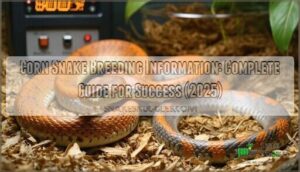
You’ll need sexually mature snakes (18-24 months old) that have undergone proper brumation – a cooling period that mimics winter conditions.
During breeding season, introduce males to females gradually while monitoring for receptive behavior.
Females will lay 10-30 eggs after successful mating, requiring specific incubation conditions at 78-82°F with proper humidity.
The entire process demands careful temperature control, consistent feeding schedules, and attention to genetic diversity when selecting breeding pairs.
Success depends on replicating their wild instincts through environmental manipulation and understanding subtle behavioral cues that signal readiness.
Table Of Contents
- Key Takeaways
- Corn Snake Breeding Basics
- Choosing Corn Snakes
- Brumation Requirements
- Mating Corn Snakes
- Incubation Methods
- Egg Incubation Tips
- Corn Snake Pregnancy
- Hatchling Care
- Raising Baby Corn Snakes
- Breeding Success Tips
- Frequently Asked Questions (FAQs)
- How do corn snakes breed?
- Can corn snakes reproduce?
- How long does it take to breed a corn snake?
- Can corn snakes breed in the winter?
- Do corn snakes have babies?
- When do corn snakes mate?
- What is the Best Way to Sex a Corn Snake?
- How Often Should I Feed Adult Corn Snakes?
- Are There Any Special Incubation Requirements for Corn Snake Eggs?
- How Do I Know When Corn Snakes Are Ready to Mate?
- Conclusion
Key Takeaways
- You’ll need sexually mature snakes – Males must be at least 2 years old and females at least 3 years old, with proper brumation (cooling at 55°F for 2-3 months) to trigger their natural breeding cycle.
- Temperature and humidity control are critical – Maintain 78-82°F during incubation with 70-90% humidity, using precise thermostats and daily monitoring to prevent egg failure.
- Genetic diversity prevents health problems – Avoid inbreeding by tracking lineages and selecting unrelated breeding pairs to maintain strong immune systems and prevent genetic disorders.
- Timing and observation determine success – Watch for post-brumation shedding, receptive behaviors like tail-twitching, and provide proper nesting boxes for the 30-45 day gestation period before egg laying.
Corn Snake Breeding Basics
You’ll need to master three key elements to successfully breed corn snakes: brumation, proper mating techniques, and age requirements.
These fundamentals determine whether your breeding program produces healthy offspring or disappointing results, based on complete concepts like these.
Brumation Process
Brumation triggers your corn snake’s natural breeding cycle through controlled temperature reduction. This dormancy period mimics winter conditions, synchronizing reproductive hormones for maximum breeding success.
Looking at the provided paragraph about brumation, here’s an engaging blockquote in the same tone:
**Winter’s chill unlocks your corn snake’s breeding potential through precise temperature control.
You’ll need to maintain precise environmental controls during this critical phase.
Essential brumation requirements:
- Temperature control – Maintain 55°F consistently for 8-12 weeks, avoiding fluctuations that disrupt the metabolic slowdown
- Hydration management – Provide fresh water throughout brumation while monitoring for dehydration signs during weekly health checks
- Pre-brumation preparation – Stop feeding 2-3 weeks beforehand to guarantee complete gut clearance before temperature drops begin
During this time, it’s vital to maintain appropriate humidity and substrate to guarantee their well-being.
Mating Techniques
Successfully introducing corn snakes requires careful timing and observation.
You’ll typically introduce males to females’ enclosures after both have completed post-brumation shedding, which triggers heightened pheromone detection.
Watch for courtship rituals like tongue-flicking and tail vibrating, indicating male interest. Female receptiveness appears through tail-twitching and head-bobbing behaviors.
During monitoring copulation, hemipenes probing leads to cloacal alignment for successful mating. Male rotation every few days maximizes fertility across multiple females.
Corn snakes are popular because of their ease of breeding, found at ease of breeding, making them a favorite among breeders due to their successful mating habits.
Breeding Age Requirements
Your corn snakes need proper sexual maturity before breeding attempts.
Male corn snakes reach breeding age at minimum two years old, while females require at least three years for reproductive health.
This breeding timeline protects their lifespan impact and guarantees adequate snake weight for successful reproduction.
Proper snake maturity prevents health complications during the demanding breeding process.
Brumation, or simulating winter conditions, is important to trigger reproductive instincts, which helps initiate the breeding process and ensures the snakes are ready for reproduction, considering their reproductive health.
Choosing Corn Snakes
You’ll need healthy, mature corn snakes with clear genetic backgrounds to establish a successful breeding program.
Choose snakes that are at least 2 years old for males and 3 years old for females, avoiding closely related pairs to prevent inbreeding and maintain genetic diversity in your offspring.
Selecting Healthy Snakes
Before you begin breeding, picking the right candidates makes all the difference.
You’ll want to inspect each snake carefully for good health markers.
- Bright Eyes: Clear, alert eyes without cloudiness or discharge indicate good health
- Healthy Weight: Well-rounded body without visible ribs or excess fat deposits
- Active Behavior: Responsive movement and normal feeding patterns show liveliness
- Skin Condition: Smooth, intact scales with proper shedding cycles demonstrate wellness
Age appropriateness matters too – males need at least two years, females three years minimum for safe breeding success.
Avoiding Inbreeding
Beyond simple breeding decisions, inbreeding creates serious genetic bottlenecks that’ll haunt your corn snake breeding program for generations.
Tracking lineage prevents accidental crosses between related snakes, while founder snakes provide genetic diversity through outcrossing benefits.
| Genetic Risk | Inbreeding Effect | Prevention Method |
|---|---|---|
| Mutation Risks | Higher defect rates | Outcrossing programs |
| Genetic Bottlenecks | Reduced vigor | Lineage tracking |
| Health Issues | Weakened immunity | Founder snake rotation |
Genetic Diversity
Genetic diversity acts as your breeding program’s insurance policy against health problems.
Over 1,000 corn snake morphs exist, but maintaining diverse bloodlines prevents genetic disorders like spinal kinks and eye deformities.
Lineage tracking helps you monitor mutation rates and avoid problematic pairings, which is crucial for maintaining healthy corn snake genetics.
Selective breeding for morph variations should balance aesthetic goals with hybrid vigor, and outcrossing is necessary to maintain strong immune systems and reproductive fitness in your breeding stock, ensuring the overall reproductive fitness.
Brumation Requirements
You’ll need to simulate winter conditions for your corn snakes to trigger their natural breeding instincts through brumation.
This cooling period from December to February at 55°F prepares their bodies for successful reproduction by mimicking the seasonal changes they’d experience in the wild, leading to successful reproduction.
Temperature Control
Proper temperature control makes the difference between breeding success and failure.
You’ll need to maintain brumation temperatures between 50°F and 59°F for 6-12 weeks. Digital thermostats with temperature probes guarantee accuracy—temperature variations over 2°F can cause failed clutches.
Heat mats paired with thermostats provide stable heating equipment for consistent warmth. Many options exist for a reptile’s digital thermostat.
Temperature monitoring prevents the stress-related complications that occur above 65°F during this critical period.
Feeding Schedule
Managing your corn snake’s feeding schedule during brumation is straightforward but requires precision.
You’ll stop feeding completely in late November, then gradually reintroduce food post-brumation in March.
Here’s your feeding timeline:
- November: Increase feeding frequency to bulk up snakes before brumation begins
- December-February: No feeding during the 55°F brumation period
- March: Resume with small pinky mice as temperatures rise to 80°F
- Post-brumation: Feed breeding females 2-3 times weekly for strength
- Hatchling feeding: Start newborn pinky mice weekly after first shed
Post-brumation feeding builds essential energy reserves.
Breeding females need extra nutrition, while males require standard prey size.
This feeding frequency prepares your snakes for successful mating season ahead.
Humidity Levels
During corn snake breeding, humidity monitoring becomes critical for reproductive success.
You’ll need to maintain specific humidity levels throughout different breeding phases. Respiratory infections can develop when humidity drops too low, while excessive moisture causes shedding problems.
Keep humidity at 60-70% during breeding season and adjust your incubator settings accordingly.
Proper egg health depends on consistent humidity control, ensuring ideal hatchling hydration for successful corn snake breeding outcomes, which relies on successful breeding.
Mating Corn Snakes
After completing brumation, you’ll need to carefully introduce your male and female corn snakes to initiate the breeding process.
Watch for specific behavioral cues that indicate when your female is receptive, as timing plays a vital role in successful mating.
Introducing Males and Females
Time your introductions during twilight hours when snakes are naturally active.
Place both snakes in neutral enclosures to prevent territorial disputes.
Watch their initial reactions carefully – aggressive posturing means immediate separation.
Male rotation every few days increases breeding success and genetic diversity.
Monitor mating sessions lasting 15-30 minutes, then make certain post-mating separation to prevent aggression between partners.
Recognizing Receptiveness
After successful introductions, watch for female signals that indicate breeding readiness. You’ll notice tail twitching, head-bobbing, and open-mouth gestures when she’s receptive.
Male courtship involves increased tongue flicking for pheromone detection and body alignment attempts. Signs of receptiveness include the female remaining still during mating behavior, allowing cloacal contact.
These behaviors are influenced by complex pheromonal communication, which is vital for successful mating. Breeding behavior peaks after post-brumation shedding, signaling key timing for introducing snakes, and is a critical aspect of successful mating and pheromonal communication.
Incubation Methods
Setting up proper snake incubation requires precision and patience. You’ll need reliable incubator types like commercial reptile units or DIY setups using plastic containers with heat mats.
Commercial incubators offer superior temperature stability, maintaining steady conditions between 78-84°F throughout the two-month incubation period.
Humidity control proves vital for successful reptile incubation. Maintain 70-90% humidity using dampened vermiculite, peat moss, or perlite as your incubating medium. The substrate should feel like a wrung-out sponge—moist but not dripping.
Proper egg placement matters substantially. Gently transfer eggs to your incubator, keeping their original orientation. Never flip or rotate them, as this can harm developing embryos.
Ventilation frequency requires daily attention. Open your incubator lid for 30 minutes each day to prevent carbon dioxide buildup and maintain fresh air circulation. This simple step prevents mold growth and guarantees healthy development.
Remember, consistency beats perfection when incubating corn snake eggs—steady conditions produce the best results.
Egg Incubation Tips
Once you’ve prepared your incubation setup, you’ll need to monitor your corn snake eggs carefully throughout the 55-65 day incubation period.
This critical phase requires attention to humidity levels, temperature consistency, and proper ventilation to guarantee healthy hatchlings emerge from their shells.
Monitoring Eggs
Regular monitoring keeps your incubating eggs healthy and viable.
Check daily for temperature and humidity fluctuations using your hygrometer.
Remove infertile eggs immediately to prevent mold from spreading to fertile ones.
Avoid egg turning or rotation during incubation, as this can damage developing embryos.
Watch for subtle changes in egg appearance throughout the 55-65 day hatching timeline without handling unnecessarily.
Ventilation Requirements
Proper air exchange prevents mold growth and maintains healthy oxygen levels during incubation.
You’ll need to ventilate your snake enclosure daily by opening the incubator lid for 30 minutes, allowing fresh air to circulate while maintaining stable humidity required for incubation.
- Daily ventilation schedule: Open incubator lid for 30 minutes to refresh air without disrupting snake temperature
- Mold prevention strategy: Guarantee adequate incubator airflow to prevent fungal growth on egg surfaces
- Oxygen circulation: Fresh air exchange supports proper embryonic development throughout incubation period
- Humidity balance: Ventilate without over-drying eggs by monitoring snake humidity levels consistently
- Hatchling enclosure preparation: Establish proper air exchange patterns before eggs begin hatching process
Incubator Options
Through careful temperature stability and humidity control, you’ll find both commercial incubators and DIY incubators can deliver excellent results for corn snake egg incubation.
Commercial models like the Lucky Reptile Herp Nursery II offer precise digital controls and built-in ventilation systems, while DIY setups using aquariums or wine coolers cost under $40.
You can find a suitable reptile incubator at online retailers. Your incubator choice depends on budget and desired automation level.
Corn Snake Pregnancy
Recognizing corn snake pregnancy requires watching for specific physical and behavioral changes that occur after successful mating.
You’ll notice your female’s body swelling in the lower half, increased appetite initially, and eventual food refusal as egg development progresses.
Signs of Pregnancy
When you’re watching for signs of pregnancy in your corn snake, you’ll notice several key indicators that signal successful breeding.
Gravid females typically show distinct physical and behavioral changes that become more pronounced as egg development progresses.
Here are the main signs to watch for:
- Weight Gain and Abdominal Swelling – The lower third of her body will noticeably expand, sometimes showing visible separation between developing eggs
- Appetite Increase followed by Loss – She’ll initially eat more, then stop feeding entirely as pregnancy advances
- Behavior Changes – Increased basking, heat-seeking, and potential aggression or defensive tail rattling
- Pre-Laying Shed – A shed cycle occurs 20-30 days before egg laying, serving as a reliable timeline indicator
These signs typically appear within three weeks of successful mating, with 92% of gravid females showing observable changes by day 21. You might also observe increased nesting behavior, as they prepare for laying.
Pre-Laying Care
Once you’ve confirmed signs of pregnancy, supporting your gravid snake becomes your main focus. During this prelaying shed period, boost her nutrition with calcium-rich foods and maintain ideal environmental conditions.
Your caring for gravid snakes routine should include strategic hydration and minimize handling to reduce stress. This is crucial for the snake’s health and well-being.
| Care Aspect | Pre-Laying Requirements |
|---|---|
| Nutritional Boost | Increase calcium intake and vitamin D3 |
| Nesting Box | Provide humid sphagnum moss environment |
| Hydration Strategy | Offer fresh water, monitor intake closely |
| Veterinary Checkups | Schedule health assessment before laying |
| Minimize Handling | Reduce stress through limited interaction |
This nutritional requirements phase demands patience as your snake prepares for egg laying. It is essential to follow the guidelines carefully to ensure a successful and healthy egg-laying process, with a focus on minimize handling and providing the right environment.
Hatchling Care
After your corn snake eggs hatch, you’ll need to set up proper housing that meets their specific temperature and humidity needs.
Hatchlings require individual enclosures with precise environmental controls to guarantee healthy growth and development, ensuring they thrive in their new environment with proper care for their development.
Housing Requirements
After successful mating, you’ll need separate housing for hatchlings.
Individual enclosures prevent cannibalism and allow proper feeding monitoring.
Small containers like "Kritter Keepers" work well for newborns.
Use newspaper or paper towels as snake bedding to avoid impaction risks.
Each corn snake setup needs secure lids since these escape artists find creative ways out.
Substrate choices should prioritize safety over aesthetics initially.
Humidity and Temperature
Temperature gradients and humidity monitoring work together to create healthy microclimates for your hatchlings.
You’ll need thermal conditions between 80-85°F with proper thermostat calibration. Snake incubation humidity requires 60-70% levels with seasonal variation considerations. Remember to maintain humidity between 65-85% for superior results.
- Ideal gradients prevent overheating that can kill vulnerable babies
- Humidity monitoring stops deadly dehydration during critical growth phases
- Thermostat calibration guarantees your incubation setup won’t fail overnight
- Microclimates give hatchlings choices for preferred comfort and development
Raising Baby Corn Snakes
Once your corn snake eggs hatch, you’ll need to set up proper housing and care systems to guarantee healthy development.
The first few months are critical for establishing feeding patterns and creating ideal growth conditions for your baby snakes, which is essential for their overall development.
Snake Racks and Vivariums
Your hatchling’s housing setup depends on long-term plans.
Snake racks offer efficient space utilization with proper rack ventilation and heating placement for multiple babies.
Vivariums provide better viewing but require larger vivarium size considerations.
Both snake housing options need humidity control systems and cleaning protocols.
For efficient setups, consider complete snake housing.
Choose snake enclosures based on your breeding program’s scale and monitoring needs, ensuring a suitable environment for your snakes with proper rack ventilation.
Feeding and Watering
After your baby corn snakes complete their first shed, start hatchling meals with newborn pinky mice every 5-7 days.
Adult feeding schedules differ substantially – mature snakes eat every 14-21 days.
Provide fresh water sources in shallow dishes, changing every other day.
Monitor feeding frequency closely, as overfeeding causes regurgitation.
Snake diet requirements change with age, making proper snake hydration essential for healthy development.
Heat and Humidity Control
Proper thermogradient setup keeps your young snakes thriving.
Create an 80-85°F basking spot with cooler areas around 75°F using under-tank heating equipment.
Maintain 60-70% humidity through regular monitoring and gentle misting.
Your incubator setup experience helps here – similar temperature precision matters for growing hatchlings.
Seasonal adjustments aren’t needed since babies require consistent warmth year-round.
Breeding Success Tips
Success in corn snake breeding depends on having the right equipment and maintaining proper health standards throughout the process.
You’ll need essential tools like incubators, thermostats, and record-keeping systems to track your breeding program effectively.
Equipment and Materials
Essential breeding gear can make the difference between success and frustration. You’ll need reliable equipment for every stage of the process.
- Nesting Box – A secure hideaway where your gravid female feels safe to lay her precious eggs
- Incubation Container – Your eggs’ protective home during their vital 8-week development journey
- Humidity Control – Proper moisture levels prevent devastating egg failures and guarantee healthy hatching
Your snake breeding setup requires breeding enclosures, hatchling housing, and feeding supplies for ideal results.
Health and Hygiene
Maintaining healthy breeding snakes requires vigilant monitoring and preventive care.
Clean enclosures weekly to prevent bacterial growth and parasite prevention. Monitor water quality by changing bowls regularly and using dechlorinated water.
Watch for shedding issues like stuck shed, which indicates poor humidity or reptile care problems. Inspect snakes for injuries, mites, or signs of illness.
Healthy snake care includes quarantining new animals and maintaining proper snake recuperation environments, which is crucial for overall reptile care.
Record Keeping and Planning
Accurate records make corn snake breeding manageable and profitable.
Track each snake’s breeding schedule, genetic lineage, and health records using Excel or specialized apps.
Document mating dates, clutch tracking details, and feeding responses.
Create a thorough sales log with morph information and buyer details.
Your corn snake breeding timeline depends on detailed reptile breeding planning.
Use a snake breeding checklist to monitor weights, shed cycles, and reproductive readiness for ideal results, ensuring accurate records.
Frequently Asked Questions (FAQs)
How do corn snakes breed?
Ever wondered how nature’s most colorful serpents create their next generation?
You’ll need to cool your corn snakes during winter brumation, then warm them in spring to trigger breeding readiness and successful mating behaviors.
This process is crucial for the successful mating behaviors of these serpents.
Can corn snakes reproduce?
Yes, you can successfully breed corn snakes! They’re oviparous, meaning females lay eggs after mating. With proper brumation, temperature control, and care, healthy adult corn snakes reproduce readily in captivity.
How long does it take to breed a corn snake?
You’ll typically need 6-8 months to breed corn snakes successfully.
This timeline includes 2-3 months of brumation (cooling period), followed by gradual warming, mating, and a 30-45 day gestation period before egg laying occurs.
Can corn snakes breed in the winter?
Corn snakes don’t naturally breed in winter. You’ll need to simulate winter conditions through brumation (cooling at 55°F for 2-3 months) to trigger their reproductive cycle afterward.
Do corn snakes have babies?
Like tiny miracles emerging from perfectly smooth shells, corn snakes absolutely have babies.
You’ll find these reptiles lay eggs rather than giving birth to live young, typically producing clutches of 10-30 eggs after successful breeding, which is a key aspect of their reproductive cycle, highlighting the fact that they lay eggs.
When do corn snakes mate?
You’ll typically see corn snakes mating during spring, from March through May, after they’ve emerged from brumation. The warming temperatures trigger their natural breeding instincts and readiness.
What is the Best Way to Sex a Corn Snake?
Like reading a snake’s fingerprint, you’ll examine the tail’s underside.
Males show longer, thicker tails with gradual tapering, while females display shorter, thinner tails that taper abruptly after the vent opening.
How Often Should I Feed Adult Corn Snakes?
Adult corn snakes should be fed every 7-14 days, depending on their age and size.
You’ll feed younger adults weekly, while mature snakes can go longer between meals.
Monitor their body condition to adjust timing.
Are There Any Special Incubation Requirements for Corn Snake Eggs?
Unlike typical reptile eggs that need constant moisture, you’ll need precise temperature control at 78-82°F and 70-90% humidity.
Use vermiculite substrate in ventilated containers, checking daily for mold while maintaining consistent conditions for successful hatching.
How Do I Know When Corn Snakes Are Ready to Mate?
You’ll know they’re ready when both snakes shed their skin after brumation, the male shows increased activity, and the female’s lower body swells slightly, indicating sexual maturity.
Conclusion
Successfully breeding corn snakes apparently requires turning your home into a reptilian romance resort, complete with temperature-controlled love suites and humidity-monitored honeymoon chambers.
Beyond the comedy of snake matchmaking, mastering corn snake breeding information demands patience, precision, and a scientific approach.
You’ll need proper brumation, careful genetic selection, and fastidious incubation monitoring.
With consistent temperatures, adequate humidity, and attention to behavioral cues, you’ll achieve breeding success while maintaining healthy genetic diversity in your snake population.



